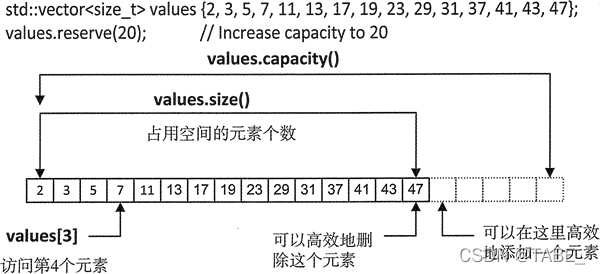C++中vector容器的注意事项总结
目录
- 容量(capacity)和大小(size)的区别
- 容器扩容的本质
- emplace_back()和push_back()的区别
- emplace()和insert()的区别
- 附:如果vector是空的,并且没有分配空间,切忌用下标进行访问,会出错!!!
- 总结
容量(capacity)和大小(size)的区别
vector 容器的容量(用 capacity 表示),指的是在不分配更多内存的情况下,容器可以保存的最多元素个数;而 vector 容器的大小(用 size 表示),指的是它实际所包含的元素个数。
对于一个 vector 对象来说,通过该模板类提供的 capacity() 成员函数,可以获得当前容器的容量;通过 size() 成员函数,可以获得容器当前的大小。例如:
#include <iostream>
#include <vector>
using namespace std;
int main()
{
std::vector<int>value{ 2,3,5,7,11,13,17,19,23,29,31,37,41,43,47 };
value.reserve(20);
cout << "value 容量是:" << value.capacity() << endl;
cout << "value 大小是:" << value.size() << endl;
return 0;
}
程序输出结果为:
value 容量是:20
value 大小是:15
结合该程序的输出结果,下图可以更好的说明 vector 容器容量和大小之间的关系:

显然,vector 容器的大小不能超出它的容量,在大小等于容量的基础上,只要增加一个元素,就必须分配更多的内存。注意,这里的“更多”并不是 1 个。换句话说,当 vector 容器的大小和容量相等时,如果再向其添加(或者插入)一个元素,vector 往往会申请多个存储空间,而不仅仅只申请 1 个。
一旦 vector 容器的内存被重新分配,则和 vector 容器中元素相关的所有引用、指针以及迭代器,都可能会失效,最稳妥的方法就是重新生成。
容器扩容的本质
vector 容器扩容的过程需要经历以下 3 步:
- 完全弃用现有的内存空间,重新申请更大的内存空间(一般是原空间的1.5倍);
- 将旧内存空间中的数据,按原有顺序移动到新的内存空间中;
- 最后将旧的内存空间释放。
由此可见,vector 扩容是非常耗时的。为了降低再次分配内存空间时的成本,每次扩容时 vector 都会申请比用户需求量更多的内存空间(这也就是 vector 容量的由来,即 capacity>=size),以便后期使用。
emplace_back()和push_back()的区别
vector中可以用来从容器末尾添加元素的函数有 2 个,分别是 push_back() 和 emplace_back() 函数。
push_back()函数的功能是在 vector 容器尾部添加一个元素,用法也非常简单,比如:
#include <iostream>
#include <vector>
using namespace std;
int main()
{
vector<int> values{};
values.push_back(1);
values.push_back(2);
for (int i = 0; i < values.size(); i++) {
cout << values[i] << " ";
}
return 0;
}
运行程序,输出结果为:
1 2
emplace_back()函数是 C++ 11 新增加的,其功能和 push_back() 相同,都是在 vector 容器的尾部添加一个元素。
emplace_back() 成员函数的用法也很简单,这里直接举个例子:
#include <iostream>
#include <vector>
using namespace std;
int main()
{
vector<int> values{};
values.emplace_back(1);
values.emplace_back(2);
for (int i = 0; i < values.size(); i++) {
cout << values[i] << " ";
}
return 0;
}
运行结果为:
1 2
emplace_back() 和 push_back() 的区别,就在于底层实现的机制不同。push_back() 向容器尾部添加元素时,首先会创建这个元素,然后再将这个元素拷贝或者移动到容器中(如果是拷贝的话,事后会自行销毁先前创建的这个元素);而 emplace_back() 在实现时,则是直接在容器尾部创建这个元素,省去了拷贝或移动元素的过程。(可以看作是零拷贝的实现)
为了让大家清楚的了解它们之间的区别,我们创建一个包含类对象的 vector 容器,如下所示:
#include <vector>
#include <iostream>
using namespace std;
class testDemo
{
public:
testDemo(int num):num(num){
std::cout << "调用构造函数" << endl;
}
testDemo(const testDemo& other) :num(other.num) {
std::cout << "调用拷贝构造函数" << endl;
}
testDemo(testDemo&& other) :num(other.num) {
std::cout << "调用移动构造函数" << endl;
}
private:
int num;
};
int main()
{
cout << "emplace_back:" << endl;
std::vector<testDemo> demo1;
demo1.emplace_back(2);
cout << "push_back:" << endl;
std::vector<testDemo> demo2;
demo2.push_back(2);
}
运行结果为:
emplace_back:
调用构造函数
push_back:
调用构造函数
调用移动构造函数
在此基础上,读者可尝试将 testDemo 类中的移动构造函数注释掉,再运行程序会发现,运行结果变为:
emplace_back:
调用构造函数
push_back:
调用构造函数
调用拷贝构造函数
由此可以看出,push_back() 在底层实现时,会优先选择调用移动构造函数,如果没有才会调用拷贝构造函数。
显然完成同样的操作,push_back() 的底层实现过程比 emplace_back() 更繁琐,换句话说,emplace_back() 的执行效率比 push_back() 高。因此,在实际使用时,建议大家优先选用 emplace_back()。
emplace()和insert()的区别
insert() 函数的功能是在 vector 容器的指定位置插入一个或多个元素。
下面的例子,演示了如何使用 insert() 函数向 vector 容器中插入元素。
#include <iostream>
#include <vector>
#include <array>
using namespace std;
int main()
{
std::vector<int> demo{1,2};
//第一种格式用法
demo.insert(demo.begin() + 1, 3);//{1,3,2}
//第二种格式用法
demo.insert(demo.end(), 2, 5);//{1,3,2,5,5}
//第三种格式用法
std::array<int,3>test{ 7,8,9 };
demo.insert(demo.end(), test.begin(), test.end());//{1,3,2,5,5,7,8,9}
//第四种格式用法
demo.insert(demo.end(), { 10,11 });//{1,3,2,5,5,7,8,9,10,11}
for (int i = 0; i < demo.size(); i++) {
cout << demo[i] << " ";
}
return 0;
}
运行结果为:
1 3 2 5 5 7 8 9 10 11
emplace()是 C++ 11 标准新增加的成员函数,用于在 vector 容器指定位置之前插入一个新的元素。emplace() 每次只能插入一个元素,而不是多个。
该函数的语法格式如下:
iterator emplace (const_iterator pos, args...);
其中,pos 为指定插入位置的迭代器;args… 表示与新插入元素的构造函数相对应的多个参数;该函数会返回表示新插入元素位置的迭代器。
举个例子:
#include <vector>
#include <iostream>
using namespace std;
int main()
{
std::vector<int> demo1{1,2};
//emplace() 每次只能插入一个 int 类型元素
demo1.emplace(demo1.begin(), 3);
for (int i = 0; i < demo1.size(); i++) {
cout << demo1[i] << " ";
}
return 0;
}
运行结果为:
3 1 2
既然 emplace() 和 insert() 都能完成向 vector 容器中插入新元素,那么谁的运行效率更高呢?答案是 emplace()。在说明原因之前,通过下面这段程序,就可以直观看出两者运行效率的差异:
#include <vector>
#include <iostream>
using namespace std;
class testDemo
{
public:
testDemo(int num) :num(num) {
std::cout << "调用构造函数" << endl;
}
testDemo(const testDemo& other) :num(other.num) {
std::cout << "调用拷贝构造函数" << endl;
}
testDemo(testDemo&& other) :num(other.num) {
std::cout << "调用移动构造函数" << endl;
}
testDemo& operator=(const testDemo& other);
private:
int num;
};
testDemo& testDemo::operator=(const testDemo& other) {
this->num = other.num;
return *this;
}
int main()
{
cout << "insert:" << endl;
std::vector<testDemo> demo2{};
demo2.insert(demo2.begin(), testDemo(1));
cout << "emplace:" << endl;
std::vector<testDemo> demo1{};
demo1.emplace(demo1.begin(), 1);
return 0;
}
运行结果为:
insert:
调用构造函数
调用移动构造函数
emplace:
调用构造函数
注意,当拷贝构造函数和移动构造函数同时存在时,insert() 会优先调用移动构造函数。
可以看到,通过 insert() 函数向 vector 容器中插入 testDemo 类对象,需要调用类的构造函数和移动构造函数(或拷贝构造函数);而通过 emplace() 函数实现同样的功能,只需要调用构造函数即可。
简单的理解,就是 emplace() 在插入元素时,是在容器的指定位置直接构造元素,而不是先单独生成,再将其复制(或移动)到容器中。因此,在实际使用中,推荐大家优先使用 emplace()。
附:如果vector是空的,并且没有分配空间,切忌用下标进行访问,会出错!!!
int main()
{
vector<int>v;
v[0]=1;
return 0;
}
成功编译,但是运行的时候报错Process finished with exit code 139 (interrupted by signal 11: SIGSEGV)。因此,当vector为空的时候,一定要用push_back()添加值。
但是,如果在定义动态数组v之后,经过了resize 或reserve之后,就可以通过下标访问
vector<int>v;
// v.resize(5); //也可以
v.reserve(5);
v[0]=1;
resize的时候会给vector里面填充0,而reserve不会
vector<int> v1;
v1.reserve(5);
for(int i=0;i<v1.size();i++)
{
cout<<v1[i]<<" ";
}
cout<<endl;
vector<int> v2;
v2.resize(5);
for(int i=0;i<v2.size();i++)
{
cout<<v2[i]<<" ";
}
运行结果:

总结
到此这篇关于C++中vector容器注意事项的文章就介绍到这了,更多相关C++ vector容器注意内容请搜索我们以前的文章或继续浏览下面的相关文章希望大家以后多多支持我们!

